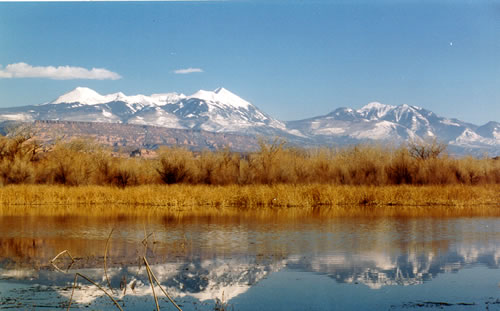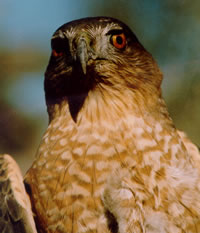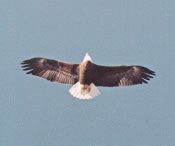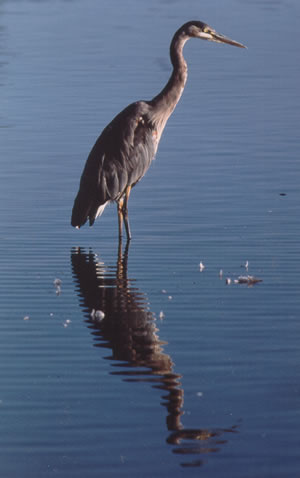| The
quiet is deafening. I stop often along the boardwalk trail,
for the crunching of old snow beneath my boots makes too much
noise. I can’t hear the birds sing, but then again,
not many are singing this time of year. Silence floods the
void; even the not-to-distant highway is silent. You just
have to love January here in the wetlands.

A husky whit interrupts my reality. Though I know the call
note by heart, I still scan the trees until I locate the tiny
yellow-rumped warbler flitting amongst the branches in the
tall cottonwood tree. Appropriately named, I catch a flash
of yellow as the bird works over the twigs and buds of the
cottonwood, picking off tiny insects that somehow withstand
this cold. Though it seems unusual to have a wintering warbler
– most of the yellow-rump’s relatives spend the
cold months in more southern climates – this species
is a fairly common winter sighting in the Matheson Preserve.
 As
I continue around the loop, the bird activity increases. Dozens
of American robins, dressed in their orange finery, descend
into a Russian olive tree and begin to gorge themselves on
seeds. The fruits are in abundance and the robins consume
the fruits, pits and all. I almost want to shout at the birds,
scare them from the tree, for I know that their droppings
will help to spread these unwanted exotic trees. The olives
invade areas where native plants could get established, and
though some wildlife forages on the fruits, research has shown
a lower diversity of wildlife species occur in Russian olive
dominated habitats versus in native habitats. Unfortunately,
the olive, like tamarisk, is a successful colonizer of disturbed
areas and tends to grow in proliferation. As
I continue around the loop, the bird activity increases. Dozens
of American robins, dressed in their orange finery, descend
into a Russian olive tree and begin to gorge themselves on
seeds. The fruits are in abundance and the robins consume
the fruits, pits and all. I almost want to shout at the birds,
scare them from the tree, for I know that their droppings
will help to spread these unwanted exotic trees. The olives
invade areas where native plants could get established, and
though some wildlife forages on the fruits, research has shown
a lower diversity of wildlife species occur in Russian olive
dominated habitats versus in native habitats. Unfortunately,
the olive, like tamarisk, is a successful colonizer of disturbed
areas and tends to grow in proliferation.
Farther along the boardwalk I run into the seeds again, this
time encased in the scats of a raccoon or maybe even a gray
fox. The highly striated seeds of the olive are easy to discern.
My scatological investigation is interrupted by the raucous
calls of the robins as a heat-seeking Cooper’s hawk
blasts through the grove. The robins scatter like gossip,
momentarily confusing the hawk. But the bird must see something
it likes, for it continues on in hot pursuit.
 I
can’t see the finish line and whether or not the Coop
collects a prize. Success means survival, and the abundance
of prey here is an attraction that draws many predators. The
smaller relative of the Cooper’s hawk is the sharp-shinned
hawk. Named for its bony legs, the sharp-shinned also prowls
the preserve in search of smaller prey like yellow-rumps,
house finches or juncos. Unlike the soaring hawks or buteos
that often hunt from an aerial vantage, the sharpie and Coop
are built for quick pursuit and navigating through thickets
of vegetation. With short, broad wings and rudder-like tails,
these accipiters hunt the woodlands while other hawks, like
the harrier, take to the open fields. I
can’t see the finish line and whether or not the Coop
collects a prize. Success means survival, and the abundance
of prey here is an attraction that draws many predators. The
smaller relative of the Cooper’s hawk is the sharp-shinned
hawk. Named for its bony legs, the sharp-shinned also prowls
the preserve in search of smaller prey like yellow-rumps,
house finches or juncos. Unlike the soaring hawks or buteos
that often hunt from an aerial vantage, the sharpie and Coop
are built for quick pursuit and navigating through thickets
of vegetation. With short, broad wings and rudder-like tails,
these accipiters hunt the woodlands while other hawks, like
the harrier, take to the open fields.
Formerly known as the marsh hawk, the northern harrier quarters
over the bulrushes and grassy fields in search of sparrows
or small rodents. With an owl-like facial disk, the harrier
has exceptional hearing abilities, which aids in its hunting.
After locating a sound, these hawks pull up and hover over
the area before descending talons outstretched. Like the sharp-shinned
hawk, northern harriers are often observed in the preserve
in winter, but they migrate northward once spring rolls around.
 Though
I strike out on the harrier today, I do catch a bald eagle
soaring over the Central Pond. Portrayed as a fierce predator,
our nation’s symbol often resorts to piracy or feeding
off carrion to survive the winter. This behavior may be related
to the bird’s preference for watery habitats that tend
to freeze over, thus forcing the bird to shift from a fish-based
diet to one of feathers or fur. Though
I strike out on the harrier today, I do catch a bald eagle
soaring over the Central Pond. Portrayed as a fierce predator,
our nation’s symbol often resorts to piracy or feeding
off carrion to survive the winter. This behavior may be related
to the bird’s preference for watery habitats that tend
to freeze over, thus forcing the bird to shift from a fish-based
diet to one of feathers or fur.
This particular bird is an adult with its unmistakable white
head and tail contrasting with the chocolate brown wings.
Carving wide circles into the deep blue sky, the bird climbs
in altitude and is soon gone from view.
I add this sighting to my list which stands at twenty-eight
species. The different habitats in the preserve attract a
diversity of bird life. From dark-eyed juncos and white-crowned
sparrows to wood ducks and buffleheads to Cooper’s hawks
and northern harriers, and all may be observed within close
proximity to town.
Later on, I leave the preserve under the shadow of cold. Still
early in the afternoon, the high cliffs block out the winter
sun. With the darkness comes the companionship of quiet that
once again descends over the preserve. Only my heavy footfalls
disturb the peace. Winter in the wetlands exaggerates the
dynamic character of this place, accentuating its seasonal
appeal to both bird and birder.

|


 As
I continue around the loop, the bird activity increases. Dozens
of American robins, dressed in their orange finery, descend
into a Russian olive tree and begin to gorge themselves on
seeds. The fruits are in abundance and the robins consume
the fruits, pits and all. I almost want to shout at the birds,
scare them from the tree, for I know that their droppings
will help to spread these unwanted exotic trees. The olives
invade areas where native plants could get established, and
though some wildlife forages on the fruits, research has shown
a lower diversity of wildlife species occur in Russian olive
dominated habitats versus in native habitats. Unfortunately,
the olive, like tamarisk, is a successful colonizer of disturbed
areas and tends to grow in proliferation.
As
I continue around the loop, the bird activity increases. Dozens
of American robins, dressed in their orange finery, descend
into a Russian olive tree and begin to gorge themselves on
seeds. The fruits are in abundance and the robins consume
the fruits, pits and all. I almost want to shout at the birds,
scare them from the tree, for I know that their droppings
will help to spread these unwanted exotic trees. The olives
invade areas where native plants could get established, and
though some wildlife forages on the fruits, research has shown
a lower diversity of wildlife species occur in Russian olive
dominated habitats versus in native habitats. Unfortunately,
the olive, like tamarisk, is a successful colonizer of disturbed
areas and tends to grow in proliferation. I
can’t see the finish line and whether or not the Coop
collects a prize. Success means survival, and the abundance
of prey here is an attraction that draws many predators. The
smaller relative of the Cooper’s hawk is the sharp-shinned
hawk. Named for its bony legs, the sharp-shinned also prowls
the preserve in search of smaller prey like yellow-rumps,
house finches or juncos. Unlike the soaring hawks or buteos
that often hunt from an aerial vantage, the sharpie and Coop
are built for quick pursuit and navigating through thickets
of vegetation. With short, broad wings and rudder-like tails,
these accipiters hunt the woodlands while other hawks, like
the harrier, take to the open fields.
I
can’t see the finish line and whether or not the Coop
collects a prize. Success means survival, and the abundance
of prey here is an attraction that draws many predators. The
smaller relative of the Cooper’s hawk is the sharp-shinned
hawk. Named for its bony legs, the sharp-shinned also prowls
the preserve in search of smaller prey like yellow-rumps,
house finches or juncos. Unlike the soaring hawks or buteos
that often hunt from an aerial vantage, the sharpie and Coop
are built for quick pursuit and navigating through thickets
of vegetation. With short, broad wings and rudder-like tails,
these accipiters hunt the woodlands while other hawks, like
the harrier, take to the open fields. Though
I strike out on the harrier today, I do catch a bald eagle
soaring over the Central Pond. Portrayed as a fierce predator,
our nation’s symbol often resorts to piracy or feeding
off carrion to survive the winter. This behavior may be related
to the bird’s preference for watery habitats that tend
to freeze over, thus forcing the bird to shift from a fish-based
diet to one of feathers or fur.
Though
I strike out on the harrier today, I do catch a bald eagle
soaring over the Central Pond. Portrayed as a fierce predator,
our nation’s symbol often resorts to piracy or feeding
off carrion to survive the winter. This behavior may be related
to the bird’s preference for watery habitats that tend
to freeze over, thus forcing the bird to shift from a fish-based
diet to one of feathers or fur. 